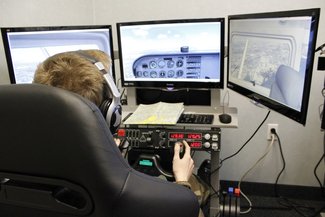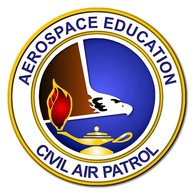|
Aerospace Education
Aerospace education involves educating CAP members and the public about the vast world of aerospace. Cadets are not only required to, but are encouraged to, explore different aspects of aerospace in order to advance in the program. Cadets are also offered five orientation flights (O-Flights), instruction in the cockpit of Civil Air Patrol aircraft with a highly-trained pilot. Senior members are expected to explore the aerospace world too, but many senior members are already pilots and offer their experience as teaching tools for cadets. Civil Air Patrol attempts to extend the appreciation of aerospace to school systems and the general public. |

Cadets receive instruction in actual Civil Air Patrol aircraft when possible, but all cadets have frequent opportunities to use simulators at weekly meetings.
Flying
The most truly exciting and hands-on part of aerospace education is being able
to fly. Cadets at Rockland Cadet Squadron have the unique advantage of having access to five flight simulators at the Airmont Challenger Center (our meeting location). The simulators are used by cadets at least once a month. They complete tasks and receive flight training from actual pilots while using the immersive simulators.
All Civil Air Patrol cadets are offered five orientation flights. There is a curriculum for each flight that cadets will review while airborne in a Civil Air Patrol Cessna 172. The only requirement to go on an O-Flight is to be a member, own a uniform, and complete a short online Aircraft Ground Handling training. As the cadet progresses through the orientation flights, each lesson (syllabus) becomes more challenging and complicated. For example, Syllabus 1 consists of basic flight controls and principles of flight, while Syllabus 4 focuses on the instruments found in the cockpit.
The most truly exciting and hands-on part of aerospace education is being able
to fly. Cadets at Rockland Cadet Squadron have the unique advantage of having access to five flight simulators at the Airmont Challenger Center (our meeting location). The simulators are used by cadets at least once a month. They complete tasks and receive flight training from actual pilots while using the immersive simulators.
All Civil Air Patrol cadets are offered five orientation flights. There is a curriculum for each flight that cadets will review while airborne in a Civil Air Patrol Cessna 172. The only requirement to go on an O-Flight is to be a member, own a uniform, and complete a short online Aircraft Ground Handling training. As the cadet progresses through the orientation flights, each lesson (syllabus) becomes more challenging and complicated. For example, Syllabus 1 consists of basic flight controls and principles of flight, while Syllabus 4 focuses on the instruments found in the cockpit.

